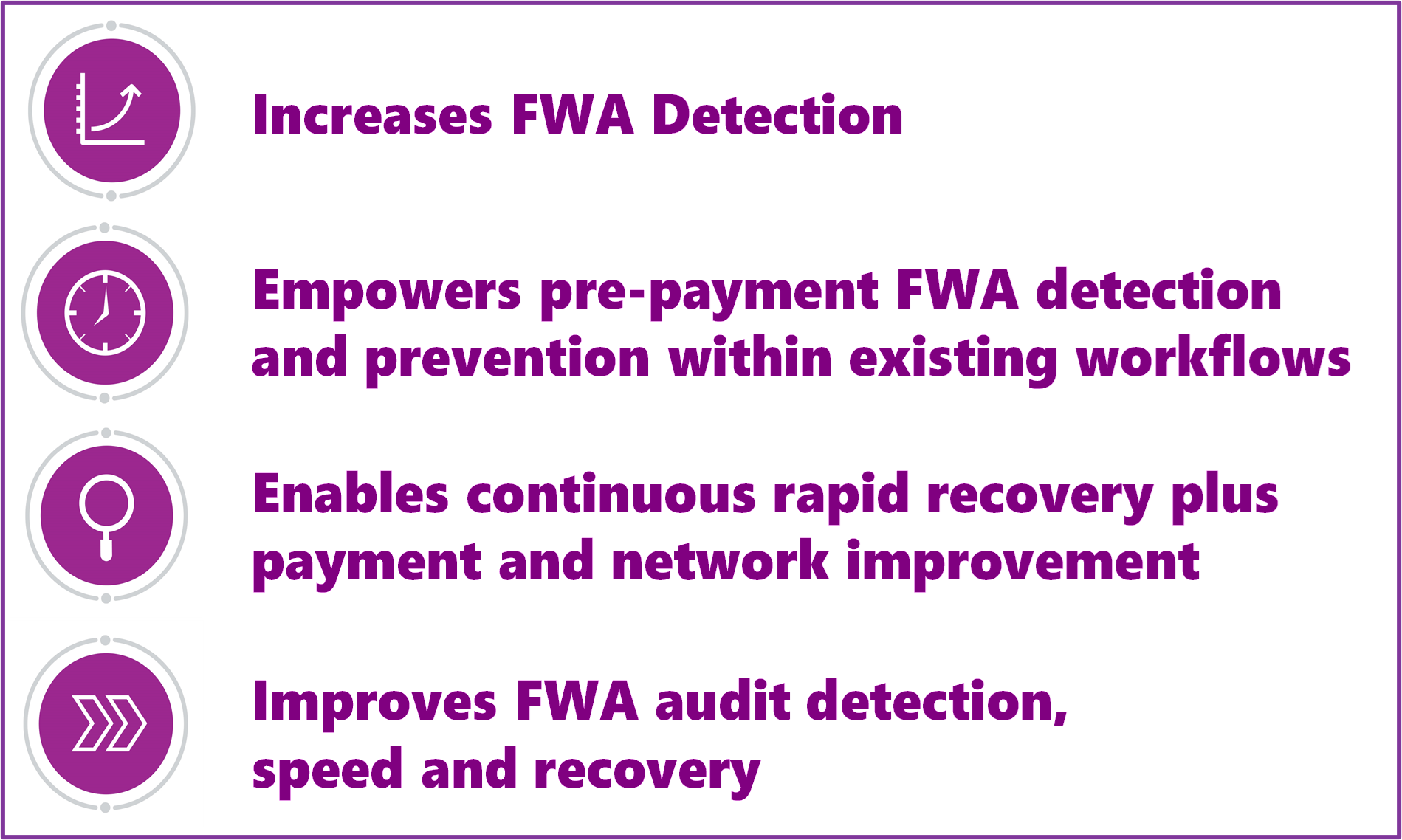Healthcare Fraud, Waste, and Abuse (FWA) costs are out of control. The National Health Care Anti-Fraud Association estimates that healthcare fraud costs the US approximately $68 billion each year. Further, the Centers for Medicare and Medicaid Services (CMS) reported that improper payments made by Medicare and Medicaid accounted for $31.46 billion in 2022. Other payers and industry organizations estimate the healthcare FWA cost to be in excess of $200 billion per year.
AI-enabled pre-payment prevention solutions can improve detection of fraudulent or abusive claims by up to 10x over antiquated rules-based engine detection and claims editing systems.
Current state of FWA in healthcare
The lack of effective detection in the industry has emboldened bad actors. According to CMS, the most common fraudulent or abusive reasons for improper payment of Medicare and Medicaid claims include:
- Insufficient Medical Necessity: Claims are submitted even though they likely should be denied, as the services provided were not deemed medically necessary or did not meet coverage guidelines
- Upcoding: Providers may bill for more complex ore xpensive services than were actually provided to the patient.
- Duplicate billing: Providers may intentionally or unintentionally submit multiple claims for the same service or procedure, resulting in overpayment.
- Fraudulent claims: Providers may intentionally submit false claims for services that were not provided or were unnecessary.
The trouble is, current claims editing technologies cannot ‘see’ much of the fraud and excessive billing activity. Most claims editing systems are based on rules or use cases, which are static and restricted to ‘seeing’ what they are told to see. They can’t detect dynamic provider behaviors, outliers, or patterns that indicate excessive billings.
Compounding the FWA problem is the current state of most healthcare insurance payers, which are laden with provider data inaccuracies, antiquated systems that use suboptimal rules-based engines for FWA detection, and labor-intensive post-payment audits and recovery efforts.
As a result of data inaccuracies and manual, labor-intensive processes, the most common non-malicious (or self-inflicted) reasons for improper payment of Medicare and Medicaid claims include:
- Insufficient documentation: Providers may not submit enough documentation to support the services billed, making it difficult for reviewers to determine the appropriateness of the claim.
- Billing errors: Providers may make errors in billing codes, quantities, dates, or other data elementsthat impact claim payment.
- Administrative errors: Claims may be denied due to administrative errors, such as incorrect beneficiary information or incomplete forms.
These reasons, along with the malicious actions noted above, all perpetuate a “pay-and-chase” approach to recovering improperly paid claims. This approach costs payers tens of millions of dollars annually, not to mention how it feeds member, provider, and employee dissatisfaction.

Current fraud detection methods
Fraud detection methods used by payers today are fairly ineffective, time-consuming, and costly. In addition to the aforementioned rules-based engines that miss FWA behaviors, common methods of finding fraud include:
- Manual claim reviews, where payers review claims submitted by providers for accuracy and completeness, including reviewing medical records to verify services were actually provided and were medically necessary
- Peer reviews, aka audits, where payers pay third parties and independent medical experts to review claims for appropriateness
- Provider credential verification, where payers may verify that providers are properly licensed and that provider data is accurate
- Patient identification verification, where payers verify patient identity and that services were actually received
In addition to the cost of auditing, identifying, and verifying FWA activity, there is the additional financial burden of attempting to recover the improperly paid claims. According to a report by Transparency Market Research, the healthcare claims audit and recovery market in the US was approximately $1.36 billion in 2019, projected to grow to $3.1 billion by 2027—a figure that does not include those internal recovery effort costs incurred by the healthcare payer.
There’s a human cost to FWA as well, even for people who are using the claims system correctly. There is no shortage of examples of patients experiencing extensive payment and processing delays for their legitimate claims because of the impact of payers chasing down fraudulent claims.
Understandably, this leads to patient frustration and erodes trust between them and their healthcare organization. Moreover, fraudulent claims can increase healthcare costs, leading to higher premiums and out-of-pocket expenses for members, which increases financial stress, dissatisfaction, and customer attrition.
There’s a better way
The current paradigm needs to be flipped on its head. Attacking FWA in arrears through labor-intensive, costly audits that lead to chasing down claims that should have never been paid in the first place…that’s not working.
Progressive companies are employing pre-payment data analysis, analyzing claims data to identify inconsistencies, patterns, and anomalies. Solutions like IBM’s FWA detection system and 4L Data Intelligence’s patented Integr8 AI platform use artificial intelligence-based predictive algorithms to flag claims that don’t meet certain criteria or guidelines, as well as identify provider behavioral abnormalities before claims payment is made.
These dynamic platforms detect and prevent claim fraud at higher rates because they view every claim in the context of provider behaviors and relationships around a claim. As provider behaviors change, the technology automatically shifts to detect the new trend, pattern, behavior, or relationship that resulted in excessive billings and outliers.
In addition, Natural Language Processing (NLP) can analyze unstructured data such as medical records, notes, and other clinical documents to identify fraudulent activities and help in claim validation. Robotic Process Automation (RPA) can then be used to automate not only the correction of obvious data errors, but also the process of identifying claims that require further review. That includes sending notifications to the appropriate parties and flagging potentially fraudulent claims for further investigation.
Finally, companies can use predictive analytics to forecast the likelihood of fraud, waste, or abuse based on historic data and past patterns, which can help identify areas of higher risk and prioritize investigative efforts.

The ROI of AI-based FWA detection
The benefits of using advanced AI-based solutions are many, and typically offer an expedited ROI. The benefits include:
- 2-10x detection improvement over leading rules-based claim editing systems
- >60% reduction in person-hours used on claims auditing
- >70% increase in audit accuracy and speed
- >40% reduction in recovery time
“In the past, a new technology to improve FWA detection meant a capital expense, more staff, and major workflow changes. The Integr8 AI FWA detection and prevention engine, however, is a cloud-based SaaS solution that requires no capital expense and integrates in with existing pre-and post-adjudication workflows, essentially serving as a bolt-on to any current claims processing system to capture immediate and continuous impact.”
– Clay Wilemon, CEO of 4L Data Intelligence
In addition to improved detection, claims processing, and recovery, automated pre-payment analysis systems provide 24-hour claim turnaround time and data to support non-payment adjudication decisions, as well as continuous, aggregated advanced provider analysis of all claims.
Implementing AI-based FWA solutions is a key factor toward delivering on the promise of intelligent operations in the Healthcare Sector. Using intelligent automation can significantly reduce FWA costs, improve accuracy, and alleviate dependency on third-party after-the-fact auditing to support recovery efforts. Delivering more accurate, prescriptive, and predictive results creates a better healthcare ecosystem for all—less waste, more knowledge, and most crucially, enhanced overall patient care.
The age of pay-and-chase is over. It’s time for proactive detection and protection.
